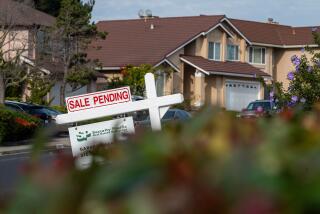Existing Homes Easier to Buy, Realtor Group Reports : Housing: Low interest rates, recovering economy help both first-time and step-up buyers. O.C. figures show big changes.
- Share via
WASHINGTON — Both first-time and step-up buyers found previously owned homes increasingly affordable in the second quarter, a real estate trade group reported Tuesday.
“The economic conditions for purchasing a home have been improving steadily for one year now,” said President William S. Chee of the National Assn. of Realtors. “With the lowest interest rates in two decades, a recovering economy and healthy home sales, this is the time for consumers to be in the market.”
The association said its Composite Housing Affordability Index shot up to 132.6 during the second quarter, highest since it measured 137.2 during the fourth quarter of 1973.
The index, which measures economic conditions affecting all home buyers, stood at 118.9 in the April-June period last year. It has risen for four straight quarters.
In Orange County, housing affordability at the end of the second quarter showed dramatic year-to-year changes.
The median price of resale homes was $222,160 in June, down from $236,960 for the same month last year, according to the California Assn. of Realtors. That put the median monthly payment at $1,470, meaning that 43% of families could qualify for homeownership.
In June, 1992, when the median monthly payment was $1,710, just 33% of Orange County families could qualify.
Another national index, measuring the ability of first-time buyers to buy an existing home, rose to 86.7 in the second quarter, up from 78.5 during the same quarter of 1992. It too has advanced four quarters in a row.
The composite index measures the ability of a family earning the median income to purchase a median-priced, previously owned home. The median means that half of the incomes are larger and half are smaller, or half of the homes cost more and half cost less.
When the index measures 100, the median family income equals the amount needed to purchase a median-priced home using conventional financing and a 20% down payment. The median income in the second quarter was $37,144.
Similarly, when the first-time buyer index registers 100, the typical first-time buyer can afford the typical starter home under existing financial conditions. The first-time buyer median income represents the typical income of a renter family with wage earners of ages 25 through 44.
The index showed that the qualifying income needed for conventional financing covering 90% of a $91,000 home during the second quarter was $27,514, compared to a median income of $23,861.
The realtors group said that while median incomes for both first-time and step-up buyers have been increasing--and contributing to overall affordability--the influence of low interest rates has had an even greater positive influence on home purchases.
Economist John A. Tuccillo noted that repeat buyers typically have a financial advantage over first-time buyers.
“Trade-up buyers have the advantage of investing their equity into another home, while first-time home buyers still have to figure a way of crossing a difficult threshold of homeownership--the down payment,” he said.
Still, with low interest rates, first-time buyers can find home financing that requires lower down payments, he said.
According to the Federal Housing Finance Board, the national average effective mortgage rate was 7.26% during the second quarter, down from 8.46% during the same period last year.
The rate is the weighted average of adjustable and fixed-rate mortgages on loans closed on existing homes. It was the lowest since 1968, when it was 7.03%.
More to Read
Inside the business of entertainment
The Wide Shot brings you news, analysis and insights on everything from streaming wars to production — and what it all means for the future.
You may occasionally receive promotional content from the Los Angeles Times.









